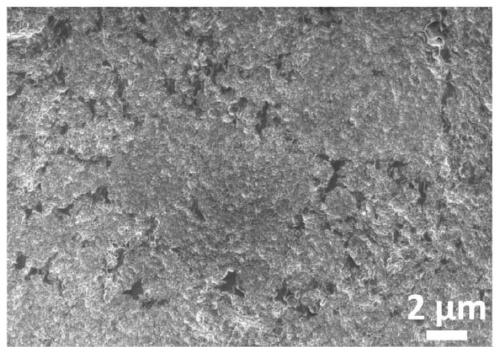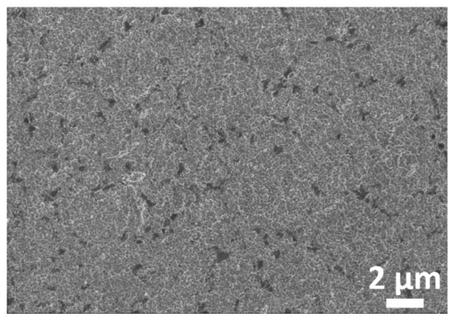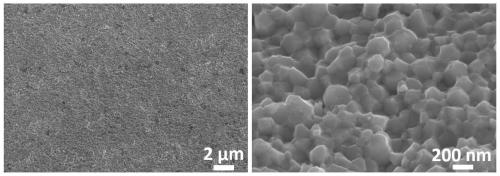Self-passivated tungsten alloy for enhancing high-temperature oxidation resistance through low-alloy elements and preparation method of self-passivated tungsten alloy
A high-temperature anti-oxidation and low-alloy technology, which is applied in the field of self-passivation tungsten alloys with low alloy elements to enhance high-temperature anti-oxidation performance and the field of preparation thereof, and can solve the problems of unfavorable high-temperature anti-oxidation performance, segregation of Cr elements, etc.
- Summary
- Abstract
- Description
- Claims
- Application Information
AI Technical Summary
Problems solved by technology
Method used
Image
Examples
Embodiment 1
[0027] Under the protective atmosphere of Ar, successively weigh 96.36g of W powder with a purity of 99.5%, 12.54g of Cr powder, 0.66g of Y powder and 0.44g of Zr powder, and put them into 250ml of WC powder together with WC balls according to the ball-to-material ratio of 5:1. In a ball milling pot, then ball milling is carried out on a planetary ball mill with a ball milling speed of 250 rad / min and a ball milling time of 80 hours to obtain homogeneous alloy powder. Then, the alloy powder is filled in the graphite mold and densified by FAST technology. Sintering process: heating rate is about 146°C / min, sintering temperature is 1150°C, pressure is 90MPa, no heat preservation.
[0028] figure 1 It is the microstructure diagram of the ZW4 alloy obtained under this process condition. It can be found that a large number of dark gray precipitates exist in the structure of the W alloy. Through the Archimedes drainage method, its relative density was measured to be higher than 9...
Embodiment 2
[0030] Under the protective atmosphere of Ar, successively weigh 96.14g of W powder, 12.54g of Cr powder, 0.66g of Y powder, 0.44g of Zr powder and 0.22g of Ti powder with a purity of 99.5% and weigh them together with WC balls according to the ball-to-material ratio of 5:1. Put it into a 250ml WC ball mill jar, and then perform ball milling on a planetary ball mill with a ball milling speed of 250 rad / min and a ball milling time of 80 hours to obtain homogeneous alloy powder. Then, the alloy powder is filled in the graphite mold and densified by FAST technology. Sintering process: heating rate is about 146°C / min, sintering temperature is 1150°C, pressure is 90MPa, no heat preservation.
[0031] figure 2 It is the microstructure diagram of the ZW5 alloy obtained under this process condition. It can be found that the size and number of segregation phases are significantly reduced after adding a small amount of Ti element to the ZW4 alloy. Through the Archimedes drainage met...
Embodiment 3
[0033] Under the Ar protective atmosphere, successively weigh 96.09g of W powder, 12.54g of Cr powder, 0.66g of Y powder, 0.44g of Zr powder, 0.22g of Ti powder and 0.055g of Si powder with a purity of 99.5%, according to the ball-to-material ratio of 5: 1 and WC balls are put into a 250ml WC ball mill jar, and then ball milled on a planetary ball mill with a ball milling speed of 250rad / min and a ball milling time of 80h to obtain homogeneous alloy powder. Then, the alloy powder is filled in the graphite mold and densified by FAST technology. Sintering process: heating rate is about 146°C / min, sintering temperature is 1150°C, pressure is 90MPa, no heat preservation.
[0034] image 3It is the microstructure diagram of the ZW6 alloy obtained under this process condition. It can be found that after adding a small amount of Ti and Si elements to the ZW6 alloy, only a small amount of segregation phase exists in the W alloy; from image 3 It can be seen that the grain size of t...
PUM
| Property | Measurement | Unit |
|---|---|---|
| Grain size | aaaaa | aaaaa |
Abstract
Description
Claims
Application Information
 Login to View More
Login to View More - Generate Ideas
- Intellectual Property
- Life Sciences
- Materials
- Tech Scout
- Unparalleled Data Quality
- Higher Quality Content
- 60% Fewer Hallucinations
Browse by: Latest US Patents, China's latest patents, Technical Efficacy Thesaurus, Application Domain, Technology Topic, Popular Technical Reports.
© 2025 PatSnap. All rights reserved.Legal|Privacy policy|Modern Slavery Act Transparency Statement|Sitemap|About US| Contact US: help@patsnap.com



